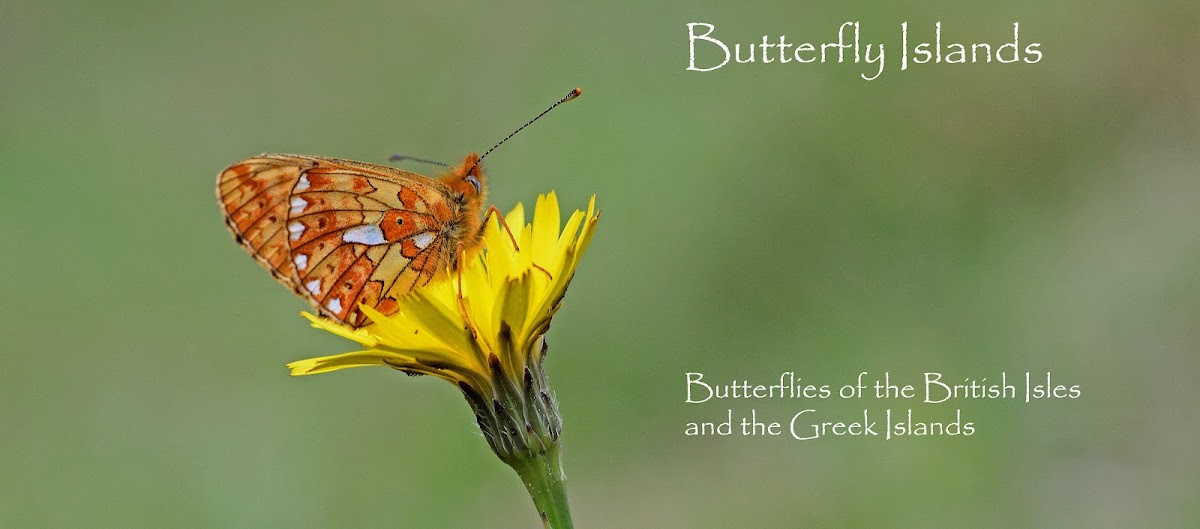The past season has thrown up several exciting sightings, such as the close encounter with White-letter Hairstreaks on an elm in Newport town centre,the joy of seeing the valezina form of the Silver-washed Fritillary in numbers at Porchfield,and finding a colony of Lesser Spotted Fritillaries on the beach on the Greek Island of Thassos. However the best must be the discovery of Glanville Fritillary pupae or chrysalies on the Island back in May.Here the habitat for this fritillary is unique as the continental Glanvilles frequent meadows,riverbanks,and woodland clearings.On the Isle of Wight it is a butterfly of our cliffs and clifftops.Therefore finding a spot to pupate can mean under stones or rocks and this is the place where these chrysalises were found.As normal they use a strand of silk to attach themselves to their chosen stone where it will take up to three weeks to emerge as an imago.
Showing posts with label May. Show all posts
Showing posts with label May. Show all posts
Sunday 15 November 2015
Thursday 30 July 2015
Something New,Something Blue.
With a report of a probable second brood of Small Blue at a nearby established colony a few days ago,I was at last able to take a look for our smallest butterfly.The weather has been very changeable over recent days but thankfully today the strong wind had abated and we enjoyed some warm sunny periods.It was not long before I came across two mating pairs and although Small Blue colonies tend to be fairly small ,such as this particular one,hopefully a few more butterflies will emerge.
The flight period is from May to late June with an occasional second brood in late July and August.At this location however it is normal for this species to appear in April.
Friday 27 February 2015
More Very Special Little Gems.
On the Isle of Wight we can look forward to our own very special butterfly again this season when the Glanville Fritillary emerges at the end of April or early May.
The female butterfly will lay up to 200 eggs on the host food plant,Ribwort Plantain.Following the fourth moult or instar the larvae build a web in order to hibernate over the winter.After the sixth and final moult the caterpillars will disperse from their protective web and pupate
When disturbed or in inclement weather the larvae will retreat back into the undergrowth behind their web and form into a protective ball.
Wednesday 19 November 2014
Thinking of Next Year.
Now that the winter is fast approaching my thoughts turn to next year and what I can look forward to seeing.Of course the first possible treat would be to see the return to our local woodland rides of the Large Tortoiseshell from early March onwards depending on the kindness of the weather.
If I am fortunate enough to visit the Greek Islands in May the wonderful sight of the Cleopatra awaits.This butterfly of the Mediterranean resembles the Brimstone in general shape and pattern but is larger in size.
Above all, the males have an extensive orange flush across the fore-wings that can be seen when in flight.This dazzling butterfly hibernates over the winter and appears again in the spring just as the first flowers are coming into bloom.
Sunday 26 October 2014
Best Bits of 2014.
Unlike 2012 and 2013 which were highlighted by sightings of the Large Tortoiseshell at Walters Copse,Newtown, this year the butterfly was not to be seen despite a good search in the spring.We can just hope that next season it will excite us with it's presence.
At the end of May I took a trip to Hod Hill in Dorset to get my first look at the Marsh Fritillary. This lovely butterfly is no longer resident on the Isle of Wight and I was not disappointed when at last I came across several individuals sheltering away in a grassy old hill fort moat from the inclement weather that day.
Another excellent highlight was a second brood of White Admirals in Walters Copse in September.This species had done well here in the summer but to see three pristine White Admirals so late in the season was a treat.
Perhaps the highlight of 2014 though,had to be recording the first Glanville Fritillaries on the wing in the UK.As usual they appeared at Wheelers Bay,Bonchurch in April.This site is always the first site to produce this unique butterfly and is followed throughout May by other Island colonies on our south west coastal cliffs.
The Glanville pictured below is from Wheelers Bay,photographed on the 30th April and it can be classed as a variant partly due to it's rather dark hind wing colouring.
Friday 4 April 2014
A Special Resident.
In the UK the Glanville Fritillary is only resident on the Isle of Wight.Therefore that makes it a very special butterfly to us here on the Island.Normally at this time the Glanville larvae are approaching full size after spending the winter months secure in a web deep in the long grass on the cliff top or the cliff slopes.The coastal cliffs along our south western shore are ideal habitat and the webs are on or very near to its foodplant, Ribwort Plantain
Now is the time for the larvae to disperse and find a safe place to pupate.The chrysalis stage lasts for about three weeks and the adult is on the wing during May and June.
Subscribe to:
Posts (Atom)





